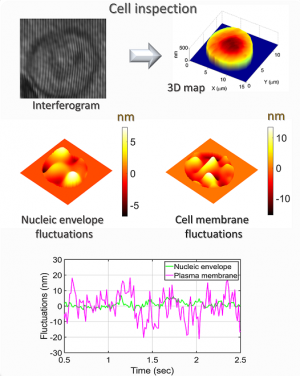
For the first time in medical history researchers at Singapore-MIT Alliance for Research and Technology (SMART) and MIT's Laser Biomedical Research Center (LBRC) have successfully designed a new technology which can pave the way for new cancer treatments as well as safer and more accurate cell therapies.
The team of researchers has found a new way to study cells, opening a new way for a better understanding of how cancers spread and become killers.
The new confocal reflectance interferometric microscope provides 1.5 micron depth resolution and better than 200 picometers height measurement sensitivity for high-speed characterization of nanometer scale nucleic envelope and plasma membrane fluctuations in biological cells.
This technology allows the researchers to use these fluctuations to understand some important biological questions such as the role of nuclear stiffness in cancer metastasis and genetic diseases.

Dr Vijay Raj Singh, SMART Research Scientist and Dr. Zahid Yaqoob, MIT LBRC Principal Investigator explained how this technology is different from existing methods. They said in a joint statement that the traditional methods for nuclear mechanics "are invasive as they either require mechanical manipulation such as stretching or require injecting fluorescent probes that 'light up' the nucleus to observe its shape. Both these approaches would undesirably change cell's intrinsic properties, limiting the study of cellular mechanisms, disease diagnosis, and cell-based therapies."
But as per both the researchers by using the confocal reflectance interferometric microscope, now "we can study nuclear mechanics of biological cells without affecting their native properties."
The scientists now believe that this new technology can be upgraded in the future to improve the throughput to tens of thousands of cells.
In addition, Dr Peter So, SMART BioSyM Principal Investigator, MIT Professor and LBRC MIT Director mentioned that currently many people die not from the primary cancer, but from the secondary cancers that form after the cancer cells metastasize from the primary site. In such cases, doctors also don't find an answer on why cancer becomes aggressive and when it happens.
"Nuclear mechanics play a vital role in cancer metastasis as the cancer cells must 'squeeze' through the blood vessel walls into the blood stream and again when they enter a new location. This is why the ability to study nuclear mechanics is so important to our understanding of cancer formation, diagnostics, and treatment," said Dr So.
It should be mentioned that the scientists are also able to use the same technology to study the effect on 'Lamin mutations' on nuclear mechanics, which causes rare genetic diseases such as Progeria that leads to fast aging in children.
This revolutionary technology was explained in a paper which was published in the prestigious academic journal, Nature Communications.










